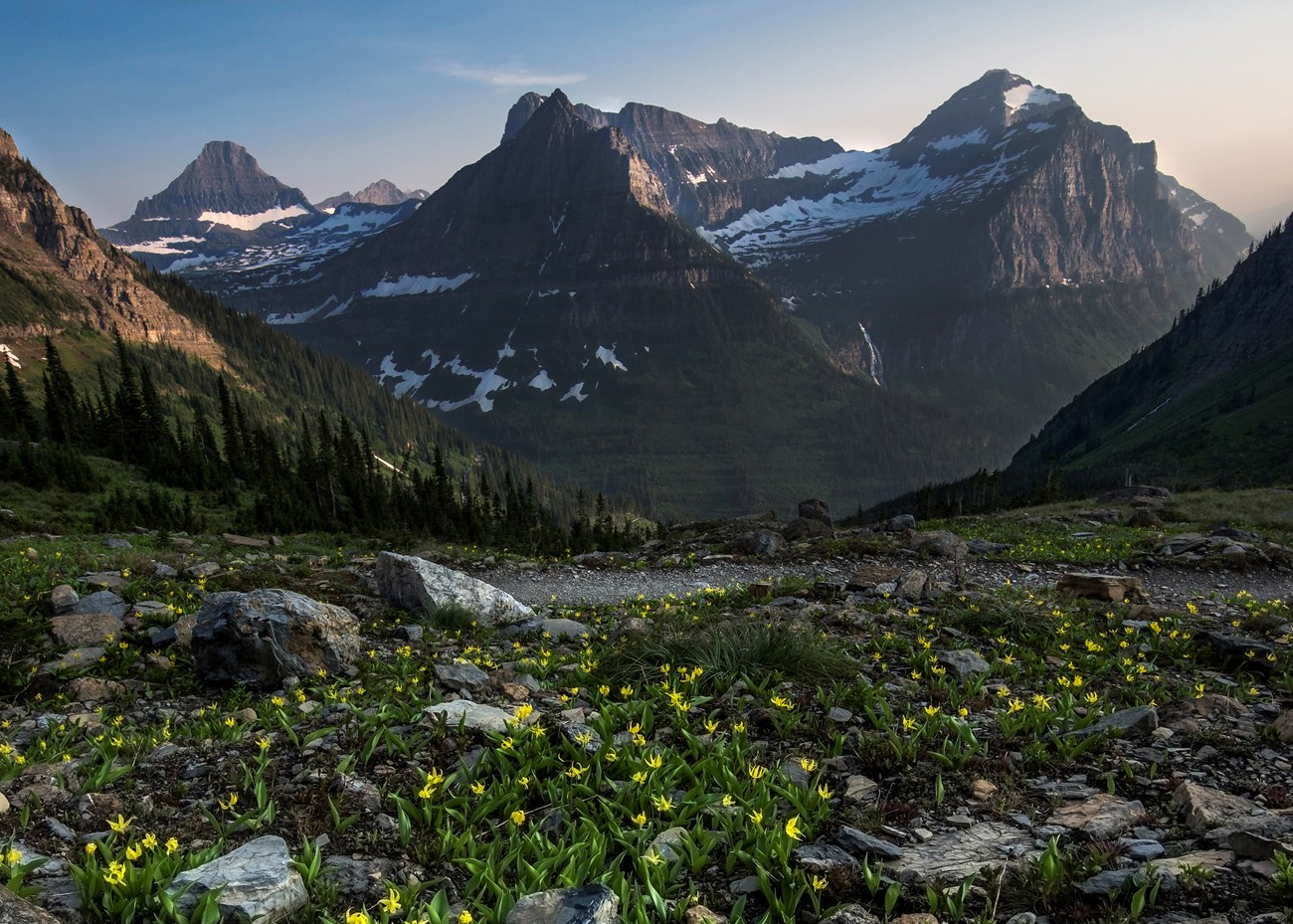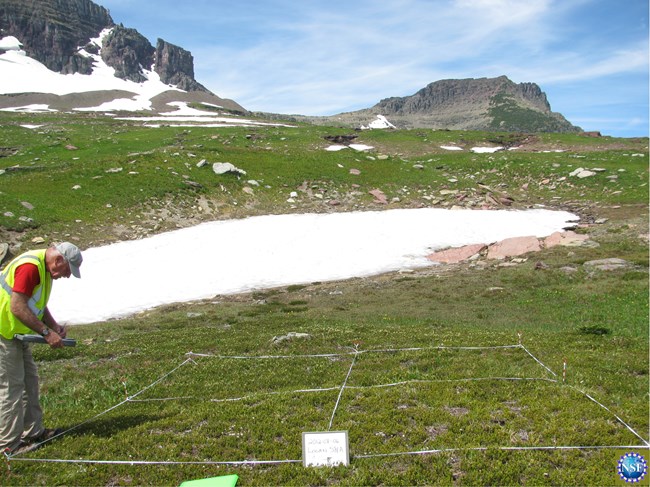Last updated: October 14, 2024
Article
Alpine Vegetation Resource Brief
Background Information

NPS
Threats
The extent and diversity of alpine habitats are currently being threatened by the potential of treeline ecotones to move upward. Treeline ecotone environments have been proposed as indicators of a changing climate due to sensitivity to warming trends. However, the process of advancement taking place in Glacier National Park is complex and can be interrupted by multiple other threats. White pine blister rust, an invasive fungus, occurs at treeline as well as among the trees on lower slopes. Also, the incidence of mountain pine beetle infestations is increasing with current warming trends. Once infected or infested, mortality rates are high, raising the likelihood of forest fires due to the increase in standing dead trees. These factors can impede the establishment of whitebark pine seedlings and therefore the treeline ecotone.
Alpine vegetation, including the alpine treeline, combines biological diversity with scenic beauty at the heart ofthe Crown of the Continent Ecosystem. It is one of the most diverse plant communities in the region with over 350 species of vascular plants, over 100 species of moss, and dozens of lichen being identified.
Temperatures decrease with elevation in the mountains. The combination of cold temperatures, short growing seasons, and sometimes thin, dry soils limit the establishment and growth of trees, leaving an array of small plants to flourish.This alpine vegetation has an incredible morphological range, from the hardscrabble Kinnikinnick (Arctostaphylos uva-ursi) to the delicately blooming alpine moss campion (Silene acaulus).The alpine treeline is a complex transition zone to the open alpine vegetation, known as an “ecotone,"with its own unique forms dependent on elevation.
Lower in the ecotone, there is typically a canopy of upright trees such as whitebark pine (Pinus albicaulis). Closer to the peaks, the trees become smaller and more widely spaced and in the presence of high winds, the trees are reshaped to krummholz (“twisted wood”) and grow in patches close to the ground. A few seedlings may shelter near these patches, boulders, or within alpine vegetation.
Status and Trends
Current treelines in the Crown of the Continent are at elevations similar to those approximately 1000 years ago. During the regional cooling of the Little Ice Age, c. 14th – 18th centuries, the treeline retreated to lower sites. While permanent snow cover may have been more extensive, the total area of alpine habitat would have exceeded today's. The treeline did advance upslope during the 19th century, as revealed by tree-ring dating, and some of the leading patches of dwarf trees and krummholz were formed in the mid-20th century.
The usual first step in the advance of trees into tundra is the establishment of a seedling of whitebark pine in the lee of a rock or other shelter from the wind, where Clark’s nutcrackers (Nucifraga columbiana) can find a place to cache a group of seeds. Whitebark pine seeds are an important food resource for the nutcrackers and other animals in Glacier, but they don’t recover all of them, leaving some behind to sprout. Once a seedling is large enough, other conifer species, such as subalpine fir (Abies lasiocarpa) can then establish in its lee where they too are protected. This sequence can repeat, forming a hedge of krummholz and dwarf trees, and eventual development of forest. If new seedlings fail to establish in this way, it becomes difficult to predict how treeline might respond to climate change.
Although alpine vegetation might seem most threatened by an advancing treeline, it is also sensitive to changes in temperatures and soil moisture. Changes in patterns of precipitation, especially in the relative amounts of rain and snow in mountain environments, are among the areas of greatest uncertainty in climate forecasting models. The most likely scenarios predict drier growing seasons, which would allow the expansion of already widespread alpine species at the expense of those usually found in proximity to late lying snowbeds. While the Crown of the Continent Ecosystem has experienced warm periods in the past 10,000 years, in this century global temperatures are on trajectory to exceed any experienced in the last one million years.

George Malanson with permission
Management Strategy
Scientists and staff at Glacier National Park are committed to the anticipation and interpretation of the changing alpine and alpine treeline ecotone environments. Study of alpine vegetation and the treeline ecotone began in the early 20th century, and today NPS botanists participate in the Global Observation Research Initiative in Alpine Environments (GLORIA), of which Glacier is the Master Site for North America.The CCRLC and the National Park Service support research by outside agencies, and Glacier has been recognized as an important field site for international scientific advances on these environments, with over 200 reports published in peer-reviewed scientific journals and books. Direct action is also possible.
The importance of whitebark pine, denoted a keystone species, and the complexity of the alpine ecosystem makes it a crucial research topic for Crown of the Continent managers.The park developed cooperative agreements with partners (US Forest Service, the Blackfeet Nation, Waterton Lakes National Park, and Montana Conservation Corps) to work together to meet a common restoration goal of reestablishing whitebark pine populations. A whitebark pine restoration program was initiated in 1998 and since 2000, over 20,000 seedlings have been planted at sites throughout the park.
Resources for More Information
Glacier National Park Staff
- Tara Carolin, Director, Crown of the Continent Resarch Learning Center
- Dawn LaFleur, Supervisory Biologist (Restoration and Invasive Plant Management)
Documents
- Butler DR, Malanson GP, Walsh SJ & Fagre DB, eds. 2009. The Changing Alpine Treeline: The Example of Glacier National Park, Montana, USA. Elsevier.
- Lesica P. 2002. A Flora of Glacier National Park, Montana. Oregon State University Press (with illustrations by D. McNeil).
- Prato T. & Fagre D. 2006. Sustaining Rocky Mountain Landscapes: Science, Policy and Management for theCrown of the Continent Ecosystem. Resources for the Future.
The Crown of the Continent Research Learning Center
Phone: 406-888-7894, Email: kylie_caesar@nps.gov
Website: Crown of the Continent Research Learning Center (U.S. National Park Service) (nps.gov)
